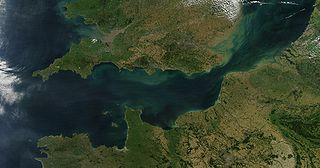
The English Channel, also called simply the Channel, is an arm of the Atlantic Ocean that separates Southern England from northern France and links to the southern part of the North Sea by the Strait of Dover at its northeastern end. It is the busiest shipping area in the world.
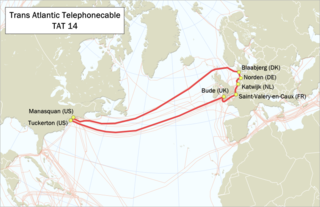
TAT-14 is the 14th consortium transatlantic telecommunications cable system. In operation from 2001, it uses wavelength division multiplexing. The cable system is built from multiple pairs of fibres—one fibre in each pair is used for data carried in one direction and the other in the opposite direction. Although optical fibre can be used in both directions simultaneously, for reliability it is better not to require splitting equipment at the end of the individual fibre to separate transmit and receive signals—hence a fibre pair is used. TAT-14 uses four pairs of fibres—two pairs as active and two as backup. Each fibre in each pair carries 16 wavelengths in one direction, and each wavelength carries up to an STM-256. The fibres are bundled into submarine cables connecting the United States and the European Union in a ring topology.
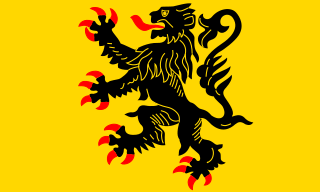
Nord-Pas-de-Calais is a former administrative region of France. Since 1 January 2016, it is part of the new region Hauts-de-France. It consisted of the departments of Nord and Pas-de-Calais. Nord-Pas-de-Calais borders the English Channel (west), the North Sea (northwest), Belgium and Picardy (south). The majority of the region was once part of the historical (Southern) Netherlands, but gradually became part of France between 1477 and 1678, particularly during the reign of king Louis XIV. The historical French provinces that preceded Nord-Pas-de-Calais are Artois, French Flanders, French Hainaut and (partially) Picardy. These provincial designations are still frequently used by the inhabitants.

The Strait of Dover or Dover Strait, historically known as the Dover Narrows, is the strait at the narrowest part of the English Channel, marking the boundary between the Channel and North Sea, separating Great Britain from continental Europe. The shortest distance across the strait, 33.3 kilometres, is from the South Foreland, northeast of Dover in the English county of Kent, to Cap Gris Nez, a cape near to Calais in the French département of Pas-de-Calais. Between these points lies the most popular route for cross-channel swimmers. The entire strait is within the territorial waters of France and the United Kingdom, but a right of transit passage under the UNCLOS exists allowing unrestricted shipping.

French Flanders is a part of the historical County of Flanders in present-day France where Flemings were traditionally the dominant ethnic group and where a dialect of Dutch was or still is traditionally spoken. The region lies in the modern-day region of Hauts-de-France and roughly corresponds to the arrondissements of Lille, Douai and Dunkirk on the southern border with Belgium. Together with French Hainaut and the Cambrésis, it makes up the French Department of Nord.
Fibre-optic Link Around the Globe (FLAG) is a 28,000-kilometre-long fibre optic mostly-submarine communications cable that connects the United Kingdom, Japan, India, and many places in between. The cable is operated by Global Cloud Xchange. The system runs from the eastern coast of North America to Japan. Its Europe-Asia segment was the fourth longest cable in the world in 2008.

Atlantic Crossing 1 (AC-1) is an optical submarine telecommunications cable system linking the United States and three European countries. It transports speech and data traffic between the U.S., the U.K., the Netherlands and Germany. It is one of several transatlantic communications cables. It was operated by American company Level 3 Communications and Irish company Tyco International, until their respective mergers in 2017 and 2016 with other companies.
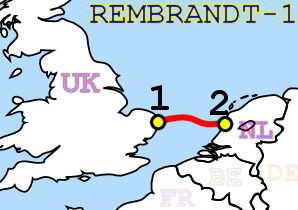
REMBRANDT-1 is a Submarine communications cable system linking the United Kingdom and the Netherlands across the southern North Sea. It is no longer in use.
REMBRANDT-2 is a submarine telecommunications cable system linking the United Kingdom and the Netherlands across the southern North Sea. It is no longer in use.

Pangea was a submarine telecommunications cable system transiting the North Sea connecting UK with Denmark and Netherlands. By 2018 it was no longer in service. It consisted of two widely separated submarine segments - Pangea North and Pangea South.

Concerto 1 is a submarine telecommunications cable system in the North Sea connecting the UK, Netherlands and Belgium. Concerto 1 was built in 1999 by Alcatel for Flute ltd, part of the Interoute group.

SEACOM launched Africa’s first broadband submarine cable system along the continent’s Eastern and Southern coasts in 2009.
ViacomCBS Networks International (VCNI) is the international division of ViacomCBS. The division oversees the production, broadcasting and promotion of key ViacomCBS' brands outside of the United States. These brands include MTV, VH1, Nickelodeon, Comedy Central, BET, Colors and Game One, as well as CBS-branded channels.

The West Africa Cable System (WACS) is a submarine communications cable linking South Africa with the United Kingdom along the west coast of Africa that was constructed by Alcatel-Lucent. The cable consists of four fibre pairs and is 14,530 km in length, linking from Yzerfontein in the Western Cape of South Africa to London in the United Kingdom. It has 14 landing points, 12 along the western coast of Africa and 2 in Europe completed on land by a cable termination station in London. The total cost for the cable system is $650 million. WACS was originally known as the Africa West Coast Cable (AWCC) and was planned to branch to South America but this was dropped and the system eventually became the West African Cable System.

BritNed is a 1,000 MW high-voltage direct-current (HVDC) submarine power cable between the Isle of Grain in Kent, the United Kingdom; and Maasvlakte in Rotterdam, the Netherlands.
The Critical Foreign Dependencies Initiative (CFDI) is a strategy and list, maintained by the United States Department of Homeland Security, of foreign infrastructure which "if attacked or destroyed would critically impact the U.S." A copy of the 2008 list was redacted and leaked by WikiLeaks on 5 December 2010 as part of the website's leak of US diplomatic cables; no details on the exact location of the assets was included in the list. The list's release was met with strong criticism from the US and British governments, while media and other countries have reacted less strongly saying that the entries are not secret and easily identified.

Cyclone Andrea was an intense European windstorm that affected western and central Europe in early January 2012.
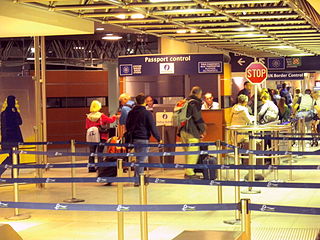
Juxtaposed controls are a reciprocal arrangement between Belgium, France, the Netherlands and the United Kingdom whereby border controls on certain cross-Channel routes take place before boarding the train or ferry, rather than upon arrival after disembarkation. With the exception of the Eurotunnel Shuttle route, customs checks remain unaffected by juxtaposed immigration controls and continue to take place upon arrival after disembarkation. Belgium, France and the Netherlands are all member states of the European Union and part of the border-free Schengen Area. The United Kingdom, on the other hand, has never participated in the Schengen Area, including when it was a member state of the European Union. As a result, juxtaposed controls aim to increase the convenience and efficiency of border checks when travelling by train or ferry between the Schengen Area and the UK by removing the need for immigration checks on arrival and by streamlining checks on departure. At the same time, juxtaposed controls are intended to detect and prevent illegal immigration. In 2016, there were over 56,000 instances when people were refused entry to the UK at the juxtaposed controls.

The Port of Calais is a port in Calais, northern France. The port is the fourth largest port in France and the largest for passenger traffic. It accounts for more than a third of economic activity in the town of Calais.















